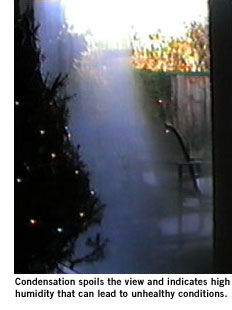Condensation and Mold
Interior mold, mildew, and condensation are problems that many homeowners face, but Eichler residents may have to deal with them more frequently than those who live in 'normal' houses. Fortunately, as is often the case with Eichler-specific issues, there are always solutions.
First, some background on the likely causes of the problem.
Nearly all Eichler homes were built with radiant-heating systems, and in the majority of Eichlers those systems are still working fine after 40 years or more. Unlike typical forced-air heating, radiant systems do not inject fresh air into the house, nor do they circulate the air.
As delightful as a warm floor feels on the feet, a lack of fresh air and circulation for prolonged periods during the colder months can make conditions more favorable for interior mold and mildew (more correctly called fungi) because of the increased humidity inside the house.
 If the interior humidity level is high enough (a common occurrence during winter, when inside temperatures significantly exceed outside temperatures), a thin film of water may form on the inside of windows and the interior surfaces of exterior walls. Known as condensation, this occurs when air is cooled to below its 'dew point', which is defined as the temperature to which air has to cool (at constant pressure and constant water vapor content) in order to reach saturation. Below the dew point, moisture precipitates out of the supersaturated air, and condensation occurs.
If the interior humidity level is high enough (a common occurrence during winter, when inside temperatures significantly exceed outside temperatures), a thin film of water may form on the inside of windows and the interior surfaces of exterior walls. Known as condensation, this occurs when air is cooled to below its 'dew point', which is defined as the temperature to which air has to cool (at constant pressure and constant water vapor content) in order to reach saturation. Below the dew point, moisture precipitates out of the supersaturated air, and condensation occurs.
Because Eichler homes have large expanses of glass, and because radiant-heated homes may have higher humidity levels, window condensation is more noticeable in Eichlers than in other houses. The original Eichler single-pane glass, which has an 'R-value' (a measure of insulating capacity) of less than R-1, does not effectively insulate the interior from the outside environment. The cold window glass provides an ideal surface for condensation formation if the interior humidity is high enough.
There are only two cures for this problem: increase the insulating value of the glass, and/or reduce the interior humidity. Ideally, homeowners need to work on both of these solutions.
The insulating value of a window can be raised by replacing it with double-pane glass or by adding an acrylic insert pane. Triple-pane windows are available, but the additional insulation gained is minimal, and the cost is considerable. Keep in mind that double-pane window seals can fail with unsightly results (cloudy, opaque windows look terrible!), so be sure the manufacturer offers at least a ten-year warranty. Better-insulated windows are unlikely to completely eliminate condensation, though they should reduce it. Interior air humidity is the real culprit. Moisture sources in the house can be poorly ventilated bathrooms, cracks in the slab, dryers that are not properly vented to the outside, even indoor fountains or aquariums. Bathroom ventilation can be dramatically improved by adding a ceiling exhaust fan/light combination in place of the original light.
If condensation is confined to a bedroom after increasing the window ventilation, it may simply be due to exhaled moisture from sleeping inhabitants. Obviously they cannot be expected to breathe less. Try leaving the door of the bedroom open (if it is normally kept shut), or keeping the door shut and opening the window a bit. Condensation may also occur on the surface of exterior walls. This could be due to poor insulation or even a total lack of insulation. Many Eichler owners are shocked when they discover that their homes may not have any insulation at all; others are surprised to find out that insulation can be added to Eichler exterior walls. As a move to potentially eliminate condensation, consider adding R-13 fiberglass insulation to all exterior walls. If nothing else, it will at least reduce the heating bill.
Mold and mildew will grow only if there is sufficient humidity in the air to provide a favorable environment. Trying to eliminate these pests with cleaning solutions may prove fruitless, as they reproduce through airborne spores.
The Drakes of Palo Alto had to take extreme measures to solve their condensation and mildew problems, installing a specialized ventilation system beneath a new foam roof. Hopefully your solution, if one is ever needed, will come more easily.




